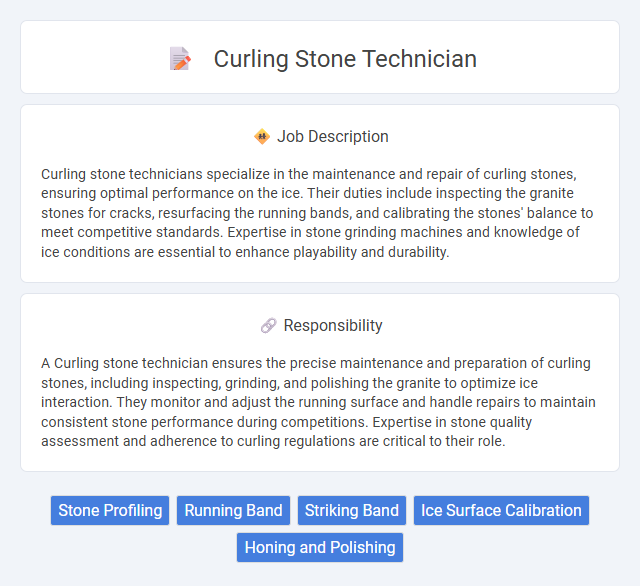
Curling stone technicians specialize in the maintenance and repair of curling stones, ensuring optimal performance on the ice. Their duties include inspecting the granite stones for cracks, resurfacing the running bands, and calibrating the stones' balance to meet competitive standards. Expertise in stone grinding machines and knowledge of ice conditions are essential to enhance playability and durability.
Individuals with strong physical stamina and excellent hand-eye coordination are more likely to excel as a curling stone technician due to the demands of maintaining precise stone conditions. Those who enjoy detail-oriented tasks and have a passion for ice sports might find this role particularly suitable. However, people with limited physical endurance or a lack of interest in technical maintenance may have lower chances of thriving in this job.
Qualification
Curling stone technicians require specialized knowledge in stone maintenance, including expertise in granite properties and surface grinding techniques. Certifications from recognized curling associations or experience in ice rink management enhance their qualifications. Precision skills in measuring stone weight and ensuring consistent rotation are crucial for optimal game performance.
Responsibility
A Curling stone technician ensures the precise maintenance and preparation of curling stones, including inspecting, grinding, and polishing the granite to optimize ice interaction. They monitor and adjust the running surface and handle repairs to maintain consistent stone performance during competitions. Expertise in stone quality assessment and adherence to curling regulations are critical to their role.
Benefit
Curling stone technicians likely experience the benefit of working closely with athletes and sports organizations, which may enhance their understanding of the sport and improve their technical skills. The role probably offers a unique opportunity to contribute to the precision and quality of curling stones, potentially leading to recognition within the curling community. There is a chance that the job provides seasonal flexibility and the satisfaction of supporting competitive gameplay.
Challenge
The job of a curling stone technician likely involves overcoming the challenge of maintaining precise standards for stone quality and performance under varying ice conditions. Success in this role may depend on the technician's ability to accurately assess wear and implement repairs that preserve the stone's optimal trajectory. Balancing technical skill with environmental factors could be a constant and demanding aspect of this position.
Career Advancement
Mastering the specialized skills of a curling stone technician opens pathways to roles such as quality control supervisor, equipment manager, and regional curling facility consultant. Expertise in stone maintenance, ice surface interaction, and repair techniques enhances employability in national and international curling organizations. Continuous professional development through certification programs and hands-on experience is crucial for advancing to leadership and technical expert positions within the curling sports industry.
Key Terms
Stone Profiling
Stone profiling in curling stone technician roles involves precise measurement and shaping of the granite stones' running bands to optimize ice interaction and stone trajectory. Technicians use specialized tools and software to create consistent surface textures and maintain the optimal concave profile that affects curl and speed. Mastery of stone profiling enhances gameplay accuracy and prolongs stone lifespan in competitive curling environments.
Running Band
A Curling stone technician specializes in maintaining and sharpening the running band, the narrow metal ring encircling the bottom of the stone that ensures smooth gliding on ice. Precise calibration and consistent profiling of the running band are essential to optimize stone performance and control during games. Advanced knowledge of metallurgy and ice friction dynamics allows technicians to enhance durability and reduce wear, ensuring peak competitive conditions.
Striking Band
A curling stone technician specializes in maintaining and repairing curling stones, with a primary focus on the striking band--the narrow steel ring around the base that makes contact with the ice. Precise assessment and adjustment of the striking band ensure optimal stone performance, affecting roll, speed, and accuracy during play. Expertise in resurfacing and band replacement directly impacts the consistency and durability of curling stones in competitive settings.
Ice Surface Calibration
Curling stone technicians specialize in precise ice surface calibration to ensure optimal stone glide and consistent play conditions. They utilize laser leveling tools and temperature controls to maintain uniform ice thickness and pebble texture, directly impacting stone speed and curl. Their expertise enhances competitive fairness by creating a meticulously balanced playing surface tailored to tournament standards.
Honing and Polishing
Curling stone technicians specialize in honing and polishing granite stones to ensure optimal ice interaction and precise stone trajectory during gameplay. The honing process refines the granite surface to create the optimal balance of scratch depth and surface smoothness, directly influencing stone curl and speed. Polishing is essential for maintaining consistent contact with the ice, reducing friction, and enhancing player control in competitive curling environments.
 kuljobs.com
kuljobs.com